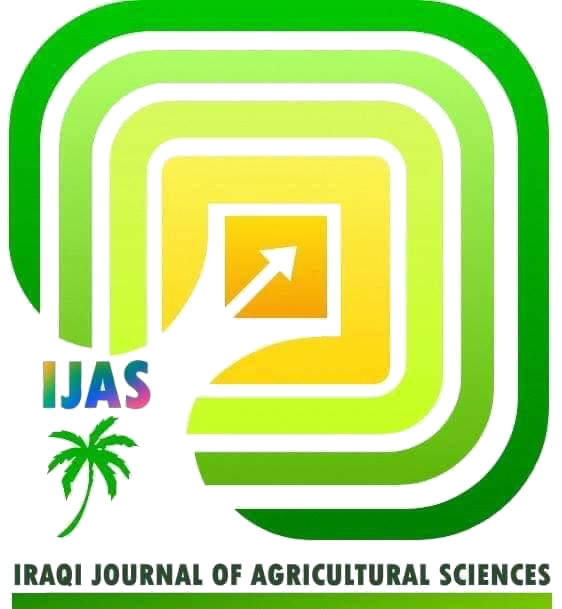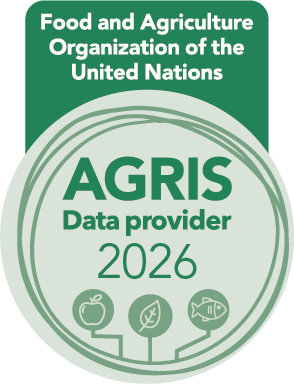USING THE ENVIRONMENTAL SENSITIVITY SCENARIOS OF DESERTIFICATION IN ARID AND SEMI-ARID REGIONS (A CASE STUDY OF THE AL-NASR AREA IN DHI QAR, IRAQ.)
DOI:
https://doi.org/10.36103/v881dy18Keywords:
irrigation, water quality, management quality, land degradation.Abstract
This study aimed to assess desertification and land degradation in an arid and semi-arid climate (Al-Nasr area, Dhi Qar Governorate). We used the MEDALUS and modified MEDALUS models with three scenarios, in conjunction with GIS mapping techniques, to identify desertification risks in one Iraqi governorate. After creating a desertification database containing 19 criteria, the first steps consisted of mapping four MEDALUS indicators, including soil, vegetation, climate, and land management. The next step involved adding other indicators such as irrigation water. All layers weighted by environmental conditions present in the region were then used according to the same MEDALUS framework to create a desertification map. The results showed that the modified MEDALUS models DSI2 and DSI3 performed better, with the unaffected type covering 44,623.6 and 48,817.2 hectares, representing 47% and 51% of the study area, while the severely affected type covered 41,971.7 and 35,490.8 hectares, representing 44% and 37% of the study area, respectively. For the DSI1 model, the unaffected type covered 28,968.6 hectares, representing 30.5%, while the affected type covered a very small area of the study area.
References
1. Abbood, R.A., A. A. Jafarzadeh, S. Oustan, and A. I. Hamad, 2025. Regional change prediction of land degradation risks using cellular automata-markov modeling in Dhi Qar Province, Iraq. Engineering, Technology & Applied Science Research. 15, 3 (Jun. 2025), 22908–22914. https://doi.org/10.48084/etasr.10483
2. AbdelRahman, M. A. E. 2023. An overview of land degradation, desertification and sustainable land management using GIS and remote sensing applications. Rend. Fis. Acc. Lincei 34, 767–808. https://doi.org/10.1007/s12210-023-01155-3
3. Abood R. H., A H. Mahdi, A. G. Khalaf, and A. Ali Kadhim, 2024. Evaluation of land cover changes in Karbala governorate using remote sensing and GIS techniques. Iraqi National Journal of Earth Science. 24 (2):177-185. https://doi.org/10.33899/earth.2023.143323.1144
4. Afzali, Sayed Fakhreddin, Ali Khanamani, Ehsan Kamali Maskooni and Ronny Berndtsson. 2021. Quantitive assessment of environmental sensitivity to desertification using the modified Medalus model in a semi- arid area.MDPI.pp:1-19. Sustainability.13 (14). 7817. https://doi.org/10.3390/su13147817
5. Ait Lamqadem, Atman, Biswajeet Pradhan, Hafid Saber, and Abdelmejid Rahimi 2018. Desertification sensitivity analysis using MEDALUS model and GIS: A case study of the Oases of Middle Draa Valley, Morocco. Sensors 18, no. 7: 2230. http://dx.doi.org/10.3390/s18072230
6. Akbari, M., M.J. Shalamzari, H. Memarian, and A. Gholami. 2020. Monitoring desertification processes using ecological indicators and providing management programs in arid regions of Iran. Ecol. Indic. 111, 106011. https://doi.org/10.1016/j.ecolind.2019.106011
7. Akram A. A. and A. I. Hamad. (2024). Spatial Variability of the heat emitted from the land surface in determining the characteristics of desert soils in AL-SAMAWAH desert using GIS. Iraq Journal of Agricultural Sciences, 55(5), 1637-1649.
https://doi.org/10.36103/03zbrj03
8. Al- Janaby H. J., A. S. Faiyyadh and M. Al-Hadithi 2023. Assessing environmental sensitivity to desertification in Heet-Haditha region-based on method, multiple criteria decision analyses. Iraqi Geological Journal. 56 (1F), 51-63. DOI: 10.46717/igj.56.1F.4ms-2023-6-12
9. Alhamdany, S. A. and Y. H. Alnaser. 2024. Assessing environmental sensitivity areas (ESA) using Medalus model in Telkaif district of northern Iraq. Asian Journal of Soil Science and Plant Nutrition 10 (3):384-93.https://doi.org/10.9734/ajsspn/2024/v10i3349
10. Alkhulaifi M. 2023. The Future threat of desertification in Iraq. Revis Bionatura. 8(2) 84. DOI. 10.21931/RB/2023.08.02.85
11. Al-Yasiry, Ahmed F., Alaa M. Al-Lami, and Ali Al-Maliki 2023. Production of environmental sensitivity maps for desertification in southern marshes of Iraq." IOP Conference Series: Earth and Environmental Science 1215, no. 1: 012023. http://dx.doi.org/10.1088/1755-1315/1215/1/012023
12. Bidi, Z., D. Khoudour, D. Sarri, S. Bensefia, S. Boufia and K. Rebbas 2025. Desertification vulnerability in arid Mediterranean ecosystems: A case study of the Boussaada sub-basin, (Southwest Hodna, Algeria). Studies in Science of Science, v. 43, n. 3, p. 143- 156. https://doi.org/10.5281/zenodo.15032417
13. Boudjemline, Fouzia, and Ahcene Semar 2018. Assessment and mapping of desertification sensitivity with MEDALUS model and GIS – Case study: basin of Hodna, Algeria. Journal of Water and Land Development 36, no.1: 17–26. http://dx.doi.org/10.2478/jwld-2018-0002
14. Capozzi, F., A. Di Palma, F. De Paola, M. Giugni ,P. Iavazzo, M.E. Topa, Adamo and P. S. Giordano 2018. Assessing desertification in sub-Saharan peri-urban areas: Case study applications in Burkina Faso and Senegal. J. Geochem. Explor., 190, https://doi.org/10.1016/j.gexplo.2018.03.012 8. 281–291
15. Dagnachew, M., S. G. Gebrehiwot, W. Bewket, T. Alamirew, K. Charles and G. Zeleke 2024. Ensuring sustainable water security through sustainable land management: Research evidences for policy. World Water Policy, 10(4), 1170–1186. https://doi.org/10.1002/wwp2.12209
16. De la Rosa, D., F. Mayol, E. Diaz-Pereira, and A. Fernandez 2004. A Land evaluation decision support system (MicroLEIS DSS) for agricultural soil protection: With special reference to the Mediterranean region. environmental modelling and software, 19(10): 929-942 https://doi.org/10.1016/j.envsoft.2003
17. Emmendorfer, L. Ramos and Gra¸ caliz Pereira Dimuro 2020. A Novel formulation for inverse distance weighting from weighted linear regression. Springer Nature Switzerland AG . V. V. Krzhizhanovskaya et al. (Eds.): ICCS 2020, LNCS 12138, pp. 576–589, 2020. https://doi.org/10.1007/978-3-030-50417-5_43
18. FAO. 2020. The State of Food and Agriculture 2020. Overcoming water challenges in agriculture. Rome. https://doi.org/10.4060/cb1447en
19. Fartm, Z.F 2020. Desertification in Iraq and how to combat It. IOP conference series earth and environmental science, 553, Article ID: 012033. https://doi.org/10.1088/1755-1315/553/1/012033
20. Ferrara, A., C. Kosmas, L. Salvati, A.Padula, G. Mancino and A. Nolè 2020. Updating the MEDALUS-ESA framework for worldwide land degradation and desertification assessment. Land Degradation and Development. http://dx.doi.org/10.1002/ldr.3559
21. Gad, A., and Rania Mansour 2023. Index Integrating soil, vegetation, climate and management qualities to evaluate desertification in the northwestern coast, Egypt." International Journal of Environmental Engineering and Development.1:250–65. http://dx.doi.org/10.37394/232033.2023.1.23
22. Ghid, Y. S., and A. I. Hamad, 2024. Assessment of the environmental sensitivity of desertification in southern Iraq, Al-Samawa Badia using GIS and RS techniques. Iraqi Journal of Agricultural Sciences: 55(3):1139-1146: https://doi.org/10.36103/cpt7vw84
23. Hamad K. O. and A. Surucu 2024. Land degradation sensitivity and desertification risk in Harrir region, northern Iraq. Heliyon 10 (2024) e27123. https://doi.org/10.1016/j.heliyon.2024.e27123
24. Hasan, S.S., O.A Alharbi, A. F. Alqurashi and A. S. Fahil 2024..Assessment of desertification dynamics in arid coastal areas by integrating remote sensing data and statistical techniques. Sustainability, 16, 4527. https://doi.org/10.3390/su16114527
25. Herrmann, S. M., A. Anyamba, and C. J. Tucker. (2005). Recent trends in vegetation dynamics in the African Sahel and their relationship to climate. Global Environmental Change, 15(4), 394-404. https://doi.org/10.1016/j.gloenvcha.2005.08.004
26. Lahlaoi, H., H. Rhinane, A. Hilali, S. Lahssini and S. Moukrim .2017. Desertification assessment using MEDALUS model in watershed Oued El Maleh, Morocco. Geosciences , 7(3), 50. https://doi:10.3390/geosciences7030050
27. Liao, J., X. Yang, Q. Ye, K. Wan, J. Sheng, S. Zhang and X. Song 2024. Assessing spatial–temporal characteristics of land desertification from 1990 to 2020 in the Heihe River Basin Using Landsat Series Imagery. Sustainability, 16, 6556. https://doi.org/10.3390/su16156556
28. Liu, H., C. Wu, Y. Yu, W. Zhao, J. Liu, JH. Yu, and et al. 2023. Effect of solar farms on soil erosion in hilly environments: A modeling study from the perspective of hydrological connectivity. Water Resources Research, 59, e2023WR035067. https://doi. org/10.1029/2023WR035067
29. Mahal, S.H., A. M and F. K. 2022. Assessment of the impact of urbanization growth on the climate of Baghdad province using remote sensing. The Iraqi Journal of Agricultural Sciences, 53(5):1021-1034. https://doi.org/10.36103/ijas.v53i5.1616
30. Masoudi, M., P. Jokar, and B.A. Pradhan. 2018. New approach for land degradation and desertification assessment using geospatial techniques. Nat. Hazards Earth Syst. Sci., 18,1133-1140.https://nhess.copernicus.org/articles/18/1133/2018/
31. Mirzabaev, A., J. Wu, J. Evans, F. García-Oliva, I.A.G. Hussein, M.H. Iqbal, J. Kimutai, T. Knowles, F. Meza, D. Nedjraoui, F. Tena, M. Türkeş, R.J. Vázquez, and M. Weltz, 2019. Desertification. In: Climate change and land: an IPCC special report on climate change, desertification, land degradation, sustainable land management, food security, and greenhouse gas fluxes in terrestrial ecosystems [P.R. Shukla, J. Skea, E. Calvo Buendia, V. Masson-Delmotte, H.-O. Pörtner, D.C. Roberts, P. Zhai, R. Slade, S. Connors, R. van Diemen, M. Ferrat, E. Haughey, S. Luz, S. Neogi, M. Pathak, J. Petzold, J. Portugal Pereira, P. Vyas, E. Huntley, K. Kissick, M. Belkacemi, J. Malley, (eds.)]. https://doi. org/10.1017/9781009157988.005
32. Morianou, G. G., N. N. Kourgialas, G. Psarras, and G. C. Koubouris 2018. Mapping sensitivity to desertification in Crete (Greece), the risk for agricultural areas. Journal of Water and Climate Change 9, no. 4 : 691–702. http://dx.doi.org/10.2166/wcc.2018.148
33. Mustafa A. M., O. R. Abd El-Kawy, Y. I. Mohamed and N. A. N. Khaled 2020. Desertification sensitivity analysis east of Siwa using GIS and remote sensing. Alexandria Science Exchange Journal.41, pp.1-14. DOI:10.21608/ASEJAIQJSAE.2020.70346
34. Ourabit, Souad, Abderrahim Ettaqy, and Mohamed EL Ghachi 2024. Assessment of sensitivity to desertification in the Oum Er-rbia watershed (UPSTREAM OF OULED SIDI DRISS) using the MEDALUS approach. Journal of Applied Life Sciences and Environment 57, no. 1(197): 149–68. http://dx.doi.org/10.46909/alse-571129
35. Ren, Yu, Xiangjun Liu, Bo Zhang, and Xidong Chen 2023. Sensitivity assessment of land desertification in China based on multi-source remote sensing. Remote Sensing 15, no.10:2674. http://dx.doi.org/10.3390/rs15102674
36. Retta, A.N., F. Kebede, M. Haile, G · Girmay, Z. Amanuel and G. Girmay 2025. Assessing the spatial variability of soil properties in the semiarid areas of Hintalo Wejerat district, Tigray region, Ethiopia. Discov. Sustain. 6, 502. https://doi.org/10.1007/s43621-025-01006-1
37. Salah H. A., A. Gh. M. lbrahim, E. G.M. Okashaa and A. H. Abd El-Azem 2023. Using a modified Medlaus model to assess the environmental sensitivity for desertification in El-Gallaba plain, New Aswan City, Aswan, Egypt. Assiut Journal of Agricultural Sciences 54 (4) 2023 (286-303). DOI:10.21608/AJAS.2023.220680.1276
38. Saleh, A. M., A. B. Belal and M. E. Jalhoum 2018. Quantitative assessment of environmental sensitivity to desertification in Sidi Abdel-Rahman area, northern west coast of Egypt. Egypt. J. Soil Sci. Vol. 58, No. 1, pp. 13 -26. DOI: 10.21608/ejss.2017.1635.1125
39. Sarbazi, M., O. Ownegh, A. Mohammadian Behbahani and M. Akbari, 2021.Quantitative assessment of the desertification intensity and risk: A Case study of Sarakhs City. Desert Ecosystem Engineering Journal10 (31). https://doi.org/15-30.10.22052/deej.2021.10.31.11
40. Shokr, M.S., M.A. Abdellatif, A. A. El Baroudy, A. Elnashar, E.F. Ali, A.A. Belal, W. Attia, M. Ahmed, A.A. Aldosari, Z. Szantoi and et al. 2021. Development of a spatial model for soil quality assessment under arid and semi-arid conditions. Sustainability, 13, 2893. https://www.mdpi.com/2071-1050/13/5/2893
41. Sobhani A and H. Khosravi.2015. Assessing environmental sensitivity areas to desertification in north of Iran. Curr World Environ; 10(3) http://dx.doi.org/10.12944/CWE.10.3.19
42. Uzuner, Ç. and O. Dengiz. 2020. Desertification risk assessment in Turkey based on environmentally sensitive areas. Ecol.Indic.114,106295. http://dx.doi.org/10.1016/j.ecolind.2020.106295
43. Vieira, R. M., J. Tomasella, R. C. S. Alvalá, M. F. Sestini, A. G. Affonso, D. A. Rodriguez and M. O. Santana, 2015. Identifying areas susceptible to desertification in the Brazilian northeast. Solid Earth, 6, 347 360. https://doi.org/10.5194/se-6-347-2015, 2015
44. Yang X., Q. Yang, H. Zhu, L. Wang, C. Wang, G. Pang, C. Du, M. Mubeen, M. Waleed and S. Hussain. 2023. Quantitative evaluation of soil water and wind erosion rates in Pakistan. Remote Sens. 2023, 15, 2404.https://doi.org/10.3390/rs15092404
45. Yin, W., Q. Hu, J. Liu, P. He, D. Zhu and A. Boali 2024. Assessing climate and land-use change scenarios on future desertification in northeast Iran: A Data Mining and Google Earth Engine-Based Approach. Land , 13, 1802. https://doi.org/10.3390/land13111802
Downloads
Published
Issue
Section
License
Copyright (c) 2025 IRAQI JOURNAL OF AGRICULTURAL SCIENCES

This work is licensed under a Creative Commons Attribution-NonCommercial 4.0 International License.

2.jpg)


